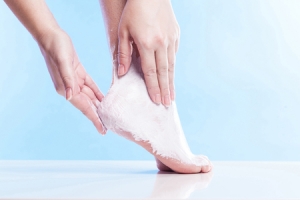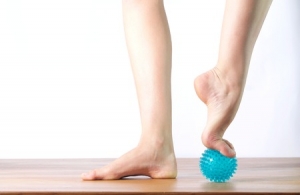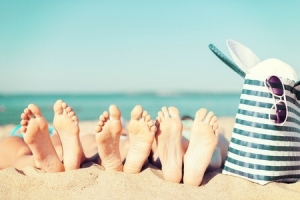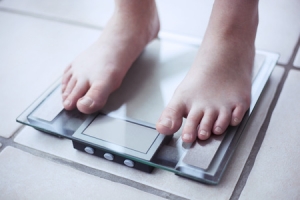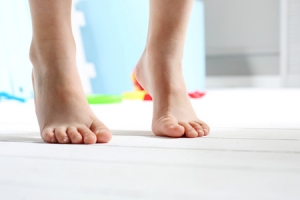Connect With Us
Blogs
Displaying items by tag: plantar fasciitis
Give Your Feet a Gift this Holiday
Tis’ the season for shopping, baking, mailing and attending festive gatherings. And who is it that enables you to enjoy all the merry making of the holiday season? It’s your feet! At Superior Foot & Ankle Care Center we’d like to suggest some great gift ideas for those two very helpful parts of your body.
Moisture Wicking Socks—if you’re a sports enthusiast or just someone who’s on the go all the time these socks will whisk perspiration away from your feet. They can also be the inner layer of a double pair of socks if a ski vacation or other colder climate trip is part of your holiday plans. Keeping feet dry helps them stay warm and can prevent fungal infections (which love moist, dark places) from developing.
Insulated Water Bottle—you may not see the immediate connection to your feet on this one but drinking plenty of water is one way to prevent edema or swelling of your lower legs, ankles and feet. This means less pain at the end of a long day.
New Pair of Walking or Running Shoes—treat your feet to top quality exercise shoes. Have your foot professionally measured at a store that specializes in fitness footwear. Be sure to tell the shoe salesman about any conditions you have such as plantar fasciitis, flat feet or overpronation. Shoes that fit properly and accommodate any deformities or existing conditions will make exercising much more pleasurable and less likely to cause an injury. An added bonus: if you’re motivated to exercise you’ll have an easier time maintaining a healthy weight—a positive factor in preventing several foot disorders.
Super Emollient Foot Cream—nothing says “thanks” like a foot massage at the end of the day with a rich lotion or cream. Feet will stay moist and supple and unlikely to develop cracks or red, flaky patches.
Podiatric Checkup—if you’ve been putting off a visit to the foot doctor to find the source of a nagging pain, stiffness or something unusual that you’ve noticed on one of your feet this may be the best gift of all. Our podiatrists, Dr. Victoria Foley and Dr. Constance Omelas will not only diagnose any discomfort you’ve been experiencing, they can also help make recommendations for shoes that will best suit your individual foot and the activities you do. To make an appointment, contact our Long Beach office at: 562-420-9800.
5 Exercises for Your Toes
Are you taking your toes for granted? At Superior Foot & Ankle Care Center we find many patients do. Your toes help you maintain your balance and enable you to push off when your walk. If toes hurt or become deformed it can lead to serious disability. Below are 5 simple exercises that will keep toes flexible and help ease foot pain for conditions such as hammertoe, bunions, toe cramps, plantar fasciitis and more:
- Big Toe Pulls: In a seated position, place feet next to each other and place a thick rubber band around the two big toes. Pull them apart, moving each toe toward the little toes. Hold the position for 5 seconds. Repeat 10 times.
- Put a Cork in It: Take small corks and place them between each of your toes on one foot. Squeeze toes together and hold for 5 seconds. Do 10 repetitions with each foot.
- Marble Pick-Up: Sitting in a chair spread 20 marbles on the floor in front of you. Pick up each marble, one at a time, with the toes of one of your feet and deposit them in a bowl. After you pick up all 20 marbles, spread them back on the floor and pick up with the other foot.
- Towel Curls: While sitting, spread towel on the floor in front of you. Using the toes on both your feet pick up the towel by curling it toward you. Repeat 5 times. Relax toes and rest a few seconds between repetitions.
- Golf Ball Massage: When you’ve finished the above exercises, reward your feet by place a golf ball on the floor and rolling it under each forefoot for 2-3 minutes.
Of course toe exercises are not a cure or solution to chronic foot pain. If you are experiencing discomfort in your feet or toes, make an appointment at our Long Beach office so that our foot doctors, Dr. Victoria Foley and Dr. Constance Omelas can examine your feet and arrive at a correct diagnosis and appropriate treatment for your foot or toe pain. Contact us by calling: 562-420-9800.
What to Bring on Summer Vacation—for Your Feet
If you’re packing for a summer trip, your feet may not be the first thing on your mind, but at Superior Foot & Ankle Care Center we want to remind patients that if your feet are hurting on vacation, you won’t enjoy yourself. The good news is your feet won’t need their own bag, just a few small items that can have a big impact on comfort, health and safety of your feet. Here’s what to bring:
- Moleskin—it’s a good idea not to bring brand new shoes that you haven’t worn before on a vacation. Chances are you’ll be doing more walking than usual and when you’re away from your closet is not the ideal time to discover that the shoes you brought are uncomfortable. Sometimes, however, even previously comfortable shoes can start to rub if it’s especially hot and your feet are sweaty from the increased activity. Moleskin can save the day. Put a small piece on the part of your foot that is feeling irritated and it will hopefully help you get through the day without a blister. Of course, you should still change your shoes as soon as possible.
- Sunscreen—this is probably already in your travel bag, but make sure you remember to apply it to the tops and bottoms of your feet as frequently as you apply to the rest of your body. Don’t forget to reapply after swimming.
- Emery board and nail clippers—a rough nail can become torn and painful. Keep an emery board with you for filing and bring along your nail clippers too. Remember to clip toenails straight across to help prevent ingrown nails from forming.
- Extra socks—if your feet tend to sweat excessively or you know you’ll be in a warm place where you’ll be doing activities like hiking or sightseeing, change your socks as soon as you feel that your feet are damp. This will help prevent a case of athlete’s foot from becoming your vacation souvenir. Fungal and bacterial infections thrive in dark, damp places.
- Flip flops—use these around the pool or at the beach to prevent feet from coming in contact with fungi in public places. Don’t wear these as your everyday shoes however, or you risk injury and other painful foot conditions such as plantar fasciitis and flat feet.
If you do injure your foot while you are away be sure to seek treatment promptly and follow up by contacting our Long Beach, CA office for an appointment when you return. Our podiatrists, Dr. Victoria Foley and Dr. Constance Ornelas will want to check your foot and be sure that it is healing properly.
What You Eat Matters to Your Feet
Did you know that a significant number of foot and ankle conditions are caused or made worse by being overweight? Plantar fasciitis, arthritis, flatfeet, tendonitis and stress fractures all have excess weight as a risk factor. In addition, carrying more pounds than you should can affect your knees, hips and back which can then lead to secondary foot problems due to changes in your gait to compensate for pain in these other parts of your body. Lastly, overweight patients are more likely to develop high blood pressure, heart disease and diabetes—all of which pose serious medical threat to your feet (not to mention the rest of your body). March is National Nutrition Month and here at Superior Foot & Ankle Care Center we would like to offer these tips to improve your diet and attain or maintain a healthy weight:
- Let’s eat in—cooking meals at home puts you at a nutritional advantage. You can control the ingredients and calories in the dishes you prepare. Good food doesn’t have to be complicated. Learn some simple dishes and up the flavor quotient with herbs, spices and citrus fruits instead of fats and creamy sauces. Choose broiling or grilling over frying as your cooking method.
- Portions matter—how much you eat is almost as important as what you eat. Ask your doctor what amount of calories you should be consuming everyday to maintain a healthy weight. Check the serving sizes in the nutrition facts for the foods you eat and adjust to your daily intake if necessary. Try using a smaller plate to automatically scale back on portions.
- Variety is the spice of life—mix up your menus. Be sure to include a colorful array of different fruits and vegetables each week. By doing so, you’ll go a long way toward ensuring that you are getting all the different nutrients you need. Explore food from different cultures.
- Add some action—try to be physically active for some part of every day. This doesn’t mean you have to go to the gym or play on a team. Take the stairs, pull weeds, walk while you talk on the phone in your office—just get moving. This will help burn calories and increase fitness. Exercise can also help fight heart and other disease.
Our podiatrists, Dr. Victoria Foley and Dr. Constance Omelas, believe in a total body approach to good health. If you have questions about your weight and your feet or are experiencing pain or discomfort in your feet currently, contact our Long Beach office for an appointment.
Resolve to Walk in the New Year
If getting in shape is one of your New Year’s resolutions, we at Superior Foot & Ankle Center would like to encourage you to consider walking. Walking is a very effective exercise, particularly if you have been inactive in the recent past. Consider these benefits:
- Can be done all year round outdoors (especially with our beautiful Long Beach weather) or indoors on a treadmill
- Walking is an activity that can be enjoyed alone or with others
- Walking lowers blood pressure, blood sugar and cholesterol while also providing a cardiovascular workout, improved circulation, stress relief and weight loss
- No special equipment is needed (except a good pair of walking shoes)
Of course walking can cause problems as well. Blisters, corns and calluses, plantar fasciitis, shin splints, and Achilles tendonitis are all potential conditions that can occur as a result of walking. You can help prevent these problems from developing, however, by following a few simple tips:
- Make an appointment for a podiatric check up before starting your new walking routine. Our board certified foot and ankle surgeons, Dr. Victoria Foley and Dr. Constance Omelas will examine your toes, feet and ankles and determine if there are any pre-existing problems that need to be treated. The foot doctor can also analyze your gait and see if you tend toward over-pronation, which may affect your shoe choice.
- Choose a sensible walking program that starts out slow and gradually increases distance and intensity.
- Always remember to stretch before and after you walk.
- Invest in good walking shoes and get professionally fitted at a sports or fitness store.
A little soreness or stiffness when you start a new fitness routine is normal but if you find you are experiencing ongoing pain or any swelling or other unusual symptoms contact our Long Beach office by calling: 562-420-9800.
“Mom, My Foot Hurts”
At Superior Foot & Ankle Care Center, our board certified foot and ankle surgeons, Dr. Victoria Foley and Dr. Constance Omelas are experts in pediatric footcare. One of the issues in evaluating children’s feet is that the patients are not able to articulate just what the problem or discomfort is. That’s when podiatrists have to become detectives and help track down the condition affecting the child. Here are some of the more common complaints we hear from our young patients and what they might mean:
“It hurts in the back of my foot.” Heel pain in children can be either an overuse issue or due to developmental factors. Medical conditions such as plantar fasciitis or Achilles tendonitis can affect children just as they do adults if an injury has occurred during a sport or if too much repetitive exercise is straining a particular part of the foot. In cases of children ages 8-15, the growth plate at the back of the heel is still forming and this leaves a vulnerable area that can become inflamed and result in calcaneal apophysitis (also known as Sever’s disease, although it is not actually a “disease”).
“It’s too far to walk.” If children complain that their feet hurt after a long walk or that their feet feel “tired,” it can be a sign of flatfeet. This can be tricky to diagnose because children don’t develop arches until between the ages of four and six. The foot doctor has a number of ways to check for flatfeet and the solution may be as simple as an insert for the shoes that will help shape and train the arch to develop properly.
“Ow! Don’t touch my big toe!” Extreme pain in the side of a toe, especially if the toe looks red and swollen is most likely pointing to an ingrown toenail. If toenails are cut to short or children pick them off and they end up with a curved edge, the nail may start to grow down and into the skin. This causes extreme pain and, if the nail actually punctures the skin, can lead to an infection.
“There’s something on the bottom of my foot.” Plantar warts are hard growths that most often form on the balls of the feet or the heel. Caused by a viral infection that enters the skin through tiny cuts, it is very common in children. They may not hurt initially but can grow and spread. Usually a topical medication or freezing will remove the wart.
As children grow and become more responsible for their own personal hygiene parent see less of their feet. It’s important to periodically examine your child’s feet and to listen seriously to foot complaints. If your child is experiencing any discomfort or pain in the toe, foot or ankle, contact our Long Beach office for an appointment today.
